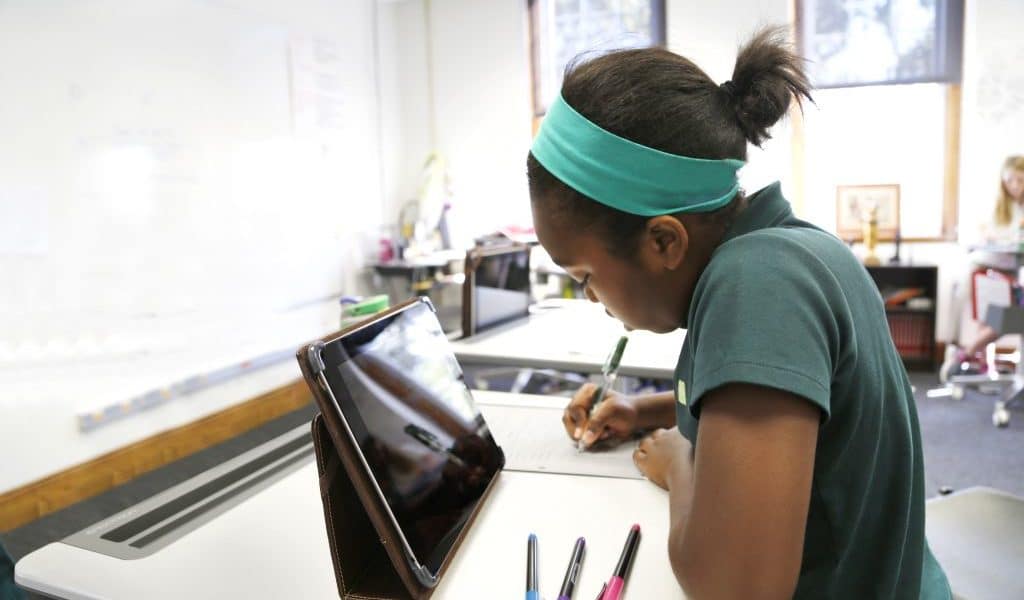Have you noticed? While there is little doubt that classrooms have become more sophisticated and digital, the physical classroom setting and furniture don’t seem to have evolved at the same pace.
It’s true.
The tablets and devices that are transforming the learning process still sit on top of the same style desks from the 1950s.
The blackboards and chalk may have been replaced by interactive whiteboards connected to a computer or projector, but far too often, students still sit in stagnant rows looking up in the same direction at the teacher for the daily lesson.
While curriculum modernization creates opportunities for teachers and students to use the classroom space more effectively, traditional classroom furniture does not. In order for the classroom to truly evolve, teachers, principals and district administrators need to address the entire classroom environment.
Consider this about classroom furniture:
* Classroom furniture at the most foundational level should enhance the educational tools and technology it’s supporting. At an aspirational level, it should also support the teachers’ curriculum, the students’ health, comfort and learning styles. This requires a fundamental change in thinking as schools adopt 1:1 technology, requiring analysis of what else is changing in association with the technology.
* Facilitating the move from traditional lectures to more group-based, collaborative and active environments requires adjustable and highly mobile furniture for both students and teachers. Stationary desks do not lend themselves to an active classroom nor do they facilitate a group-dynamic or mobile learning environment that has become so prevalent in today’s educational system.
* A desk that is both height-adjustable and mobile will foster an individualized learning environment that addresses these issues and offers a myriad of benefits to teachers, students and the school.
Why adjustable desks?
Access to adjustable furniture has been proven to help reduce fidgeting distractions, give teachers more time to teach, increase student engagement, improve academic performance and enliven curriculum.
In addition, the rising concerns about childhood health issues are addressed when students are given an alternative to sitting all day—introducing standing into the classroom is an effective means to break up sedentary behavior. We’ve seen this played out dozens of times in our schools across the country.
Input from surveys, interviews and case studies have all demonstrated that teachers prefer desks that facilitate movement and that students adapt to them intuitively. These types of desks foster collaborative learning while satisfying a child’s need for motion and allow for the teacher to use every inch of the environment for instruction.
Given today’s intersection of technology and education, the classroom set-up is at a crossroads. Schools like the Alexandria Country Day School in Virginia get the critical role classroom furniture can play in making today’s classrooms healthier, more collaborative and more conducive to learning even as schools prepare for the next wave of digital instruction.
It is time to “stand up” for important and fundamental changes for today’s classroom and the classroom of the future.
Personalized, Flexible Classrooms
We think the future of classroom furniture is personalized flexibility. What do we mean by that?
To adapt to the fluid environment of their classrooms, teachers need equipment that allows them to change their teaching style at a moment’s notice. And kids deserve desks that enable full engagement with the teacher and classmates, as the subject and assignment dictate.
Ideally, classroom furniture should help keep the entire class focused on the learning process, the teacher’s attention on the subject at hand, and both adaptable to the best possible presentation of the knowledge at any given moment.
Kids Are Stressed and Technology Isn’t Helping
The ultra-connected younger generations look to technology to navigate day-to-day life from how they get from point A to point B, stay connected to friends and interact with the world. But technology may not be helping young people when it comes to day-to-day stress.
A new survey by GENYOUth and Thrive Global asked young people ages 11 to 19 questions about their stress levels, physical activity and technology usage.
The results tell a surprising story – today’s kids are stressed out and want more opportunities to be healthy, but they don’t feel like technology is helping them.
Here’s what the survey found:
Stress is a concern
Approximately 60 percent of respondents reported feeling stressed frequently. As an organization that’s passionate about improving the health and well-being of students, this is an area of great concern. Stress can leave students feeling irritable and less focused, which impacts academic success. Chronic stress has more dangerous implications, including increased risk for disease or cardiovascular issues.
It’s crucial that we give young people the tools to properly manage stress – the sooner the better. Physical activity is a key tool to boost metabolic activity and help alleviate stress, especially low-level physical activity (LLPA).
With innovative classroom furniture like height-adjustable standing desks, students can benefit from LLPA integrated into classroom time through an active learning environment.
A technology disconnect
More than half of respondents reported that they are interested in technology like apps, fitness trackers and websites to support their overall health and wellness. But the survey found that only one in 10 young people use technology effectively in this area.
With the survey reporting that 45 percent of students believe that technology can help relieve stress, we need to take advantage of this opportunity and repair this disconnect.
The root of the problem may be the fact that 42% of respondents said that new health-related apps or devices are not designed for “people my age.” Organizations need to reassess how they develop and maintain health and wellness tools to ensure they meet the needs of all age groups – especially young people who should start leading a healthy lifestyle early on.
Better yet, providing young people with the right ergonomic guidelines and equipment to use technology comfortably ensures they can further enhance their well-being for the long-term.
Good habits for life
The classroom is a place for learning, and the lessons extend beyond the curriculum. Students are learning manners, how to interact with others, and the social norms of society.
One of the main social norms they learn – unconsciously – is sitting. They, in turn, develop the same bias toward sitting that most of us have as adults.
With everything we know about the links between learning, physical activity and health, it’s our responsibility to transform classrooms to minimize sedentary behavior.
Kids want to be active beyond limited physical education class time and recess. The survey found that 68 percent of students want to stand and move during class.
Introducing LLPA into sedentary classrooms with sit-stand desks is a health-enhancing way to boost students’ metabolism and engagement.
Through small, non-disruptive changes, we can use LLPA to help students keep heart rates a bit higher and maintain insulin effectiveness, which leads to more alert and engaged students. This also helps them manage stress levels and develop a movement-mindset to prepare them for a healthier future.
This information is courtesy of Ergotron, www.ergotron.com. For more than three decades, Ergotron has offered affordable ergonomic products to computer users bringing comfort, wellness and improved productivity into schools.










